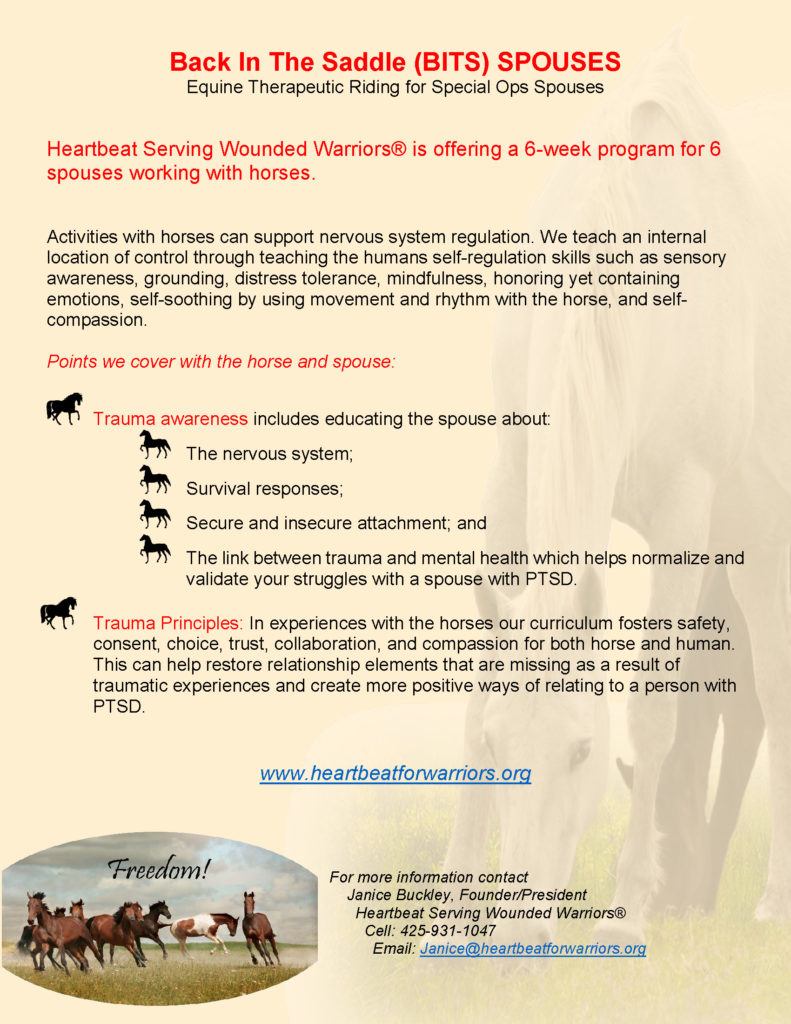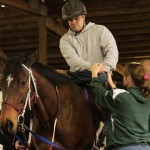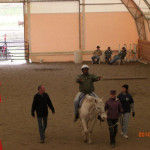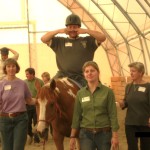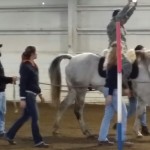Equine Therapeutic Riding Program
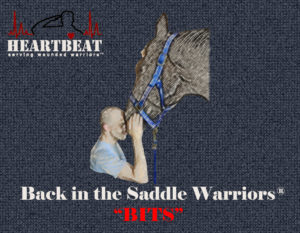
Back in the Saddle Warriors® (BITS) is Heartbeat’s clinical and evidence based Equine Therapeutic Riding Program.
For Wounded Warriors to include Vietnam forward to Global War On Terror /OIF/ OEF who are either active duty or out of the military including any branch in WA state, a Level ll Centered Riding Instructor and PATH Instructors, Volunteers are also used as sidewalkers.

Check out our latest eBook introducing our Therapy Programs
BITS Warriors Brochure for Wounded Warriors in WA State
No Previous Horse Experience Required for Any of Our Bits Programs!



WILD HORSES NEED OUR HELP
A lot of times Warriors, after being in our BITS therapeutic program, think about getting their own horse or maybe you who are reading this do. Please consider the plight of these beautiful horses. Consider adopting a rescue horse so they do not have to go through the horrid slaughter pipeline. One such non- profit is Fortheloveofthehoof.org.
Please also consider www.horseplushumanesociett.org as a nonprofit resource to adopt a rescue. They do amazing work all over the the country on behalf of horses that desparately need our help!
We have a choice to be part of the solution!
Thank you!
Janice
Check out our newest BITS program for SPOUSES
From a wounded Soldier in our BITS equine therapeutic program
“Hello Janice,
My wife has been transferred to Hawaii we leave the first week in February. I would like to give up my slot to another deserving veteran. Your program has helped me beyond and thru anything I thought possible who knew horses could do that for me?
I am so grateful for the opportunity to do this and let me know if there is anything I can do help you with this program!”
The Effectiveness of Heartbeat’s Hippotherapy and Equine Therapeutic Riding Validated Statistically
by Janet Raulerson
Definition and background of statistical analysis:
Statistical Analysis is defined as the science of collecting and presenting large amounts of data to discover underlying patters. Heartbeat utilized statistical analysis to compare the effectiveness of our Equine Therapeutic Riding Program and our Hippotherapy Program. We utilized 6 aspects to evaluate: pain level, mood, flexibility, anxiety, physical tension and ability to focus. Heartbeat wanted to see if there was a significant difference between the before rating and the after rating of the therapies; and if there was a difference, was that difference only due to chance or results of the therapy. The use of the p value in statistical analysis helps decide this. The p value represents the probability that the results of the therapy are caused by chance alone. The smaller the p value, the less likelihood that the results are due to chance.
Most analysis use a p value of 0.05 to determine that the results are not by chance but are due to the therapy. In our analysis, the p value was calculated to be 0.0001. This means that the difference between the before and after results was attributed to chance only 1 time out of 10,000. This level of difference is very significant. Bottom line, the therapies are making a substantial difference in the Wounded Warriors’ lives.
Defining Hippotherapy and Equine Therapeutic Riding:
In 2010, Heartbeat Serving Wounded Warriors initiated a clinical, cutting edge Hippotherapy program, appropriately named Back in the Saddle Warriors. The American Hippotherapy Association (AHA), founded in 1992, defines Hippotherapy as “the movement of the horse as a strategy by physical therapists (PT), occupational therapists (OT), and speech-language pathologist (SLP) to address impairments, functional limitations, and disabilities in patients with neuromusculoskeletal dysfunction.
Essentially, warriors perform different physical therapy maneuvers while on the horse. This requires them to perform a number of maneuvers and respond to the horse’s movements at the same time. The net effect is improved muscle tone, balance, posture, coordination, strength and flexibility. Balance is particularly important for warriors with Traumatic Brain Injury (TBI). Horses and humans have something in common, a pelvis that works and moves the same way. Both have identical hip movements when walking. Sitting on a moving horse allows the warrior’s body to move naturally. It strengthens muscle groups. Staying upright on a horse requires balance, coordination and muscle strength. Injuries from war may have affected those abilities and these can be helped by this therapy.
Although the horse is utilized as a physical therapy tool, the animal can offer much more. The warriors respond emotionally as well as physically to the horse. These animals are gentle and sensitive, and have a unique ability to sense human emotions. Horses are also able to mirror the warrior’s emotions so that he has a better understanding of where he is emotionally. This special bond helps warriors work through difficult issues. This can build confidence and change their outlook on life. In short, it can help bring healing.
In 2018, Heartbeat added a second therapy program to Back in the Saddle Warriors: Equine Therapeutic Riding. This therapy teaches the warrior to ride while working on posture, balance and confidence. As stated earlier, balance is very important for those warriors with TBI. Riding on the horse also has a positive impact, and affects the body brain connection in a positive way.
Design and set up of the therapy programs:
Data was collected in the form of pre therapy and post therapy evaluations for 6 different aspects: pain, anxiety, flexibility, physical tension, mood and ability to focus. Each warrior would rate each aspect on a scale of 1 to 10 with 1 being no pain, no anxiety, very flexible, relaxed, good mood and good ability to focus. A rating of 10 represented maximum pain, high anxiety, tight, tense, negative mood, and poor ability to focus. Data was collected for Hippotherapy from December 18th, 2012 to November 2nd, 2014 (173 therapy sessions); January 13th, 2015 to December 13, 2016 (86 therapy sessions); and January 7, 2019 to July 17, 2019 (51 therapy sessions). Equine Therapeutic Riding utilized that same 6 aspects and same evaluation forms for the months of January 2, 2018 to July 17, 2019 (125 therapy sessions).
The Hippotherapy data and the Equine Therapeutic Riding data were analyzed separately. After comparing all of the before and after data in a paired t-test, the results showed an extremely significant difference with a p value of .0001. Therefore, the warriors showed extremely significant improvement in terms of pain level, anxiety, flexibility, physical tension, mood and ability to focus for both Hippotherapy and Equine Therapeutic Riding. Heartbeat also noted that several of the warriors were able to come off many of their medications and one warrior that needed a cane for walking was able walk independently after weeks of Equine Therapeutic Riding.
Heartbeat is continuing to keep evaluations on all of the warriors involved in each of the two programs for further analysis. We are extremely excited that both of these therapies can now be validated both qualitatively as well as quantitatively.
Courageous Warrior Mike in our Equine Therapeutic Riding Program BITS Warriors. Mike is paralyzed on his left side, both arm and leg. He loves this program.
BITS Video Gallery
How Equine Therapeutic Riding Works
These evidence-based therapies improve muscle strength, psychological well-being, motor development, balance, and coordination. Therapy addresses many injuries including
- Spinal cord injuries
- Speech injuries
- Loss of limbs
- Post-traumatic stress disorder
- Traumatic brain injury
- Attention-deficit/hyperactivity disorder
- Diagnosis of Multiple Sclerosis (MS)
- Cancer
Click here for a great informational flyer on Equine Therapeutic Riding Riding
Check out the following Ride Along Demonstration by The Shea Center
The J.F. Shea Therapeutic Riding Center, located in San Juan Capistrano CA, is dedicated to improving the lives of people with disabilities through therapeutic horse-related programs. http://www.sheacenter.org/
BITS Photo Gallery
Back in the Saddle FAQ
What is the difference between a wounded and injured service member?
The military defines these terms differently. If the soldier is hurt in an accident while here at home, it’s called an injury. If the soldier is hurt while in a battle or war, it’s called wounded. That is also the term if the soldier is in a car accident while overseas.
Does Heartbeat help both wounded and injured soldiers?
Most of our programs are for both wounded and injured.
Why do you help only the wounded? Don’t others need your help too?
All warriors and their families deserve our time and appreciation. Many organizations serve both wounded and non-wounded. We did at one time too. We realized that we could serve more wounded warriors if we focused completely on them.
How do the soldiers feel about the help Heartbeat provides?
Wounded warriors often send words of appreciation. They’re families are grateful too. Sometimes they write letters. Sometimes they tell us in person. They let us know the huge impact our programs have on their lives.
What is Back in the Saddle Warriors®?
Back in the Saddle Warriors is Heartbeat’s clinical and evidence based Equine Therapeutic Riding Program.
For Wounded Warriors who were part of GWOT and include OIF/OEF who are either out of the Military including any branch or still in but wounded in WA state, PATH Instructors, Volunteers are also used as sidewalkers.
These evidence-based therapies improve muscle strength, psychological well-being, motor development, balance, and coordination. Therapy addresses many injuries including
- Spinal cord injuries
- Speech injuries
- Loss of limbs
- Post-traumatic stress disorder
- Traumatic brain injury
- Attention-deficit/hyperactivity disorder
What is Equine Therapeutic Riding?
Equine Therapeutic Riding is an equine-assisted therapy. The warrior sits on the horse and uses its movement as a physical therapy. This isn’t horseback riding as we usually think of it.
Licensed physical therapists, occupational therapists, and speech therapists provide this treatment. While the warrior sits on the horse, the therapist guides the animal and makes changes in its movements. The warrior’s health goals determine how and when these changes are made.
Equine Therapeutic Riding therapy team includes horse trainers certified through the Professional Association of Therapeutic Horsemanship (PATH International).
How does Equine Therapeutic Riding work?
Horses and humans have something in common, a pelvis that works the same way. Both have identical hip movements when walking. While sitting on a moving horse, this allows a person’s body parts to move naturally. It strengthens muscle groups.
Even for someone without injuries, staying upright on a horse requires balance, coordination, and muscle strength. War injuries sometimes affect these abilities. Equine Therapeutic Riding may help wounded warriors make improvements not achieved with other treatments.
How does Equine Therapeutic Riding help emotionally?
Warriors are natural protectors. It’s their job to take charge and perform brave acts every day. Injuries sometimes make it impossible to contribute any longer. It dramatically changes the warrior’s role — in the family, in the job, and in society.
The relationship between human and horse is a special one. Horses, gentle and sensitive, have a unique ability to sense human emotions. This special bond helps warriors work through difficult issues.
Equine Therapeutic Riding helps wounded warriors find newfound strength. This success contributes to positive, lifelong changes. In turn, this affects family and society.
How does a wounded warrior qualify for help?
Almost anyone can make the first call to Heartbeat to get help — warrior, family member, or provider. After the warrior’s health care provider approves treatment, we can offer the service. The provider can be an occupational therapist, physical therapist, speech therapist, or doctor.
Who qualifies to be in our Equine Therapeutic Riding Program?
- At this time we only serve Wounded or Injured from Vietnam forward to include GWOT which includes OIF and OEF in Washington State.
Who pays for the Equine Therapeutic Riding Program?
As with all our programs and services, donations are the only source of support for Back in the Saddle Warriors. We offer services free to our heroes.
Our brave, wounded warriors sustained their injuries while they defended our freedom and way of life. They put their lives on the line for complete strangers. Heartbeat firmly believes all of us owe it to our heroes to help them heal.
Where do I go for therapy?
Please e-mail or call Heartbeat for information about locations.
How can I volunteer?
At this time, Scuba Warriors serves wounded GWOT Warriors in WA State. IF you are a wounded warrior in another state, you are welcome to be in this program, BUT, unfortunately, we do not have funds for travel and lodging.
Heartbeat received a seed grant from Infinite Hero Foundation to start a limited Scuba Warrior expansion to our courageous wounded Marines in NC and Wounded Warrior Regiment East at Camp Lejeune. It IS the Vision of Heartbeat Serving Wounded Warriors® to take Scuba Warriors Nationally.
1. IF you are a dive shop or Dive Instructor that would like to be involved in Scuba Warriors in your state please contact us. IF you are a Dive Master or Dive Con certified and want to volunteer, please contact us.
2. IF you are a wounded warrior in a moderate to heavy military populated state and would like to see Scuba Warriors there, please contact us. IF you are a Command that would like to see Scuba Warriors come to you for your wounded warriors, please contact us.
3. Finally, even though our VISION is to take Scuba Warriors Nationally, we Can Not do this without YOUR HELP.
4. Please consider making a single donation or monthly donation to allow us to make Scuba Warriors Outreach a viable reality! DONATE HERE. Thank you for making a difference in the lives of these courageous Warriors that have given so much for our country!

